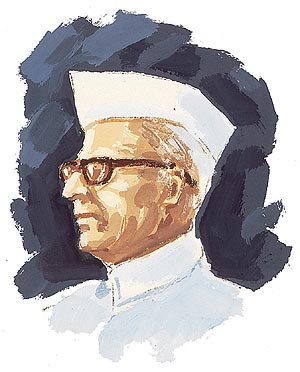THIS man was an institution, not only because he founded the Bharatiya Vidya Bhavan, one of the leading education institutes in the country, but also because of the vastness of his genius. Being a patriot, freedom fighter, scholar, reformer, and educationalist, K. M. Munshi was a colossal figure in public life for the good part of the twentieth century.
 Kanaiyalal Maneklal Munshi was born in Broach in south Gujarat. He got his primary education, so to speak, at his mother's knee, his secondary education from Khan Bahadur Dalal High School, Broach, and later he had the privilege of having a stalwart like Sri Aurobindo Gosh for a teacher at Baroda College. Under Sri Aurobindo's influence, he got attracted to armed rebellion against the British, and even learnt to make bombs. But when he moved to Bombay in 1915, he drifted towards the Home Rule Movement, and was later elected member of the Subjects Committee of the Indian National Congress in 1917.
Kanaiyalal Maneklal Munshi was born in Broach in south Gujarat. He got his primary education, so to speak, at his mother's knee, his secondary education from Khan Bahadur Dalal High School, Broach, and later he had the privilege of having a stalwart like Sri Aurobindo Gosh for a teacher at Baroda College. Under Sri Aurobindo's influence, he got attracted to armed rebellion against the British, and even learnt to make bombs. But when he moved to Bombay in 1915, he drifted towards the Home Rule Movement, and was later elected member of the Subjects Committee of the Indian National Congress in 1917.
The other influences in his life were Gandhi, Patel, Bhulabhai Desai, and Jinnah. After completing his Law degree from Bombay University, he enrolled himself as advocate in 1913, and soon became a member of the Bar. As his fame spread, he started getting cases from all over India. About this time his first novel was being serialised in a Gujarati weekly.
During World War I, he was influenced by the Home Rule movement. When Sardar Patel was organising the Bardoli Satyagraha, Munshi lent his support, and when Gandhi announced the Salt Satyagraha, he joined the movement along with his wife. He started the movement for a Parliamentary wing of the Congress, and later became Secretary of the Congress Parliamentary Board in 1938. The same year he founded the well-known Bharatiya Vidya Bhavan and Institute of Agriculture at Anand.
Between 1907 and 1915, Munshi strove for the fusion of different sub-castes of the Bhargava Brahmins. In 1912-13, he took part in the activities of the Social Reform Association and championed the cause of widow remarriage. He in fact showed the way by marrying Lilavati, a widow, in 1922. In 1939, he founded the Children's Home for the delinquent children at Chembur, Bombay.
In 1941, Munshi resigned from the Congress, and started the Akhand Hindustan Movement. On Gandhi's advice he rejoined the Congress, and was elected to the Constituent Assembly. Nehru appointed him to the Experts' Committee for drafting the Constitution of India.
When the situation in Hyderabad was critical, he lent all his experience as Agent-General to bring it under control. He was appointed Union Food and Agriculture Minister, and also served as Governor of Uttar Pradesh.
Since Munshi believed in a strong opposition, he along with C. Rajagopalachari, became one of the founders of the Swatantra Party. But he is best remembered for his efforts to promote education in India. He founded the Panchagani Hindu High School in 1924, and the following he took active part in the movement for founding a university in Gujarat. He was also elected a Fellow of the University of Bombay, where he was largely responsible for giving regional languages adequate representation, and was also instrumental in starting the department of Chemical Technology. H. H. the Gaikwad of Baroda nominated him on the Baroda University Commission.
A prolific writer and conscientious journalist, Munshi started a Gujarati monthly called Bhargava, was joint-editor of Young India, and he started the Bhavan's Journal in 1954. Some of his better-known books are: Gujarat and its Literature, Akhand Hindustan, Glory that was Gujardesh, The Ruin that Britain Wrought, The End of an Era, and Shishu ane Sakhi. He was also President of the Sanskrit Viswa Parishad, the Gujarati Sahitya Parishad, and the Hindi Sahitya Sammelan.
http://www.tribuneindia.com/2000/20000507/spectrum/main2.htm
No comments:
Post a Comment